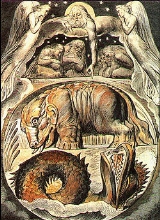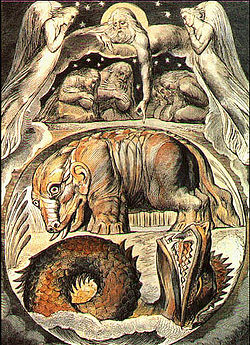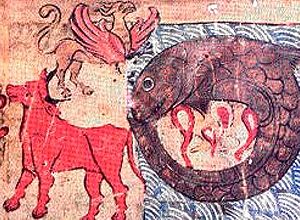
Behemoth
Encyclopedia

Book of Job
The Book of Job , commonly referred to simply as Job, is one of the books of the Hebrew Bible. It relates the story of Job, his trials at the hands of Satan, his discussions with friends on the origins and nature of his suffering, his challenge to God, and finally a response from God. The book is a...
, 40:15-24. Metaphor
Metaphor
A metaphor is a literary figure of speech that uses an image, story or tangible thing to represent a less tangible thing or some intangible quality or idea; e.g., "Her eyes were glistening jewels." Metaphor may also be used for any rhetorical figures of speech that achieve their effects via...
ically, the name has come to be used for any extremely large or powerful entity.
Plural as singular
The feminine plural Hebrew noun behemoth is used in Joel 1:20, where it is rendered "wild animals." Job 40 is an example of the use of a plural noun suffix to mean "great", rather than plural. Another example is ElohimElohim
Elohim is a grammatically singular or plural noun for "god" or "gods" in both modern and ancient Hebrew language. When used with singular verbs and adjectives elohim is usually singular, "god" or especially, the God. When used with plural verbs and adjectives elohim is usually plural, "gods" or...
for God, singular.
Description
JobBook of Job
The Book of Job , commonly referred to simply as Job, is one of the books of the Hebrew Bible. It relates the story of Job, his trials at the hands of Satan, his discussions with friends on the origins and nature of his suffering, his challenge to God, and finally a response from God. The book is a...
40:15-24 describes Behemoth, and then the sea-monster Leviathan
Leviathan
Leviathan , is a sea monster referred to in the Bible. In Demonology, Leviathan is one of the seven princes of Hell and its gatekeeper . The word has become synonymous with any large sea monster or creature...
, to demonstrate to Job
Job (Biblical figure)
Job is the central character of the Book of Job in the Hebrew Bible. Job is listed as a prophet of God in the Qur'an.- Book of Job :The Book of Job begins with an introduction to Job's character — he is described as a blessed man who lives righteously...
the futility of questioning God, who alone has created these beings and who alone can capture them. Both beasts are chaos monsters destroyed by the deity at the time of creation. Leviathan is identified with the primeval sea (Job 3:8;Ps. 74:13), and in apocalyptic literature describing the end-time, as that adversary of the deity before creation will finally be defeated. In the divine speeches in Job, Behemoth and Leviathan are composite and mythical creatures with enormous strength, which humans like Job could not hope to control. But both are reduced to the status of divine pets, with rings through their noses and Leviathan on a leash.
15 Behold now the behemoth that I have made with you; he eats grass like cattle.
16 Behold now his strength is in his loins and his power is in the navel of his belly.
17 His tail hardens like a cedar; the sinews of his thighs are knit together.
18 His limbs are as strong as copper, his bones as a load of iron.
19 His is the first of God's ways; [only] his Maker can draw His sword [against him].
20 For the mountains bear food for him, and all the beasts of the field play there.
21 Does he lie under the shadows, in the cover of the reeds and the swamp?
22 Do the shadows cover him as his shadow? Do the willows of the brook surround him?
23 Behold, he plunders the river, and [he] does not harden; he trusts that he will draw the Jordan into his mouth.
24 With His eyes He will take him; with snares He will puncture his nostrils.
In later Jewish writings
In Jewish aprocrypha and pseudepigrapha such as the 2nd century BCE Book of EnochBook of Enoch
The Book of Enoch is an ancient Jewish religious work, traditionally ascribed to Enoch, the great-grandfather of Noah. It is not part of the biblical canon as used by Jews, apart from Beta Israel...
, Behemoth is the primal unconquerable monster of the land, as Leviathan
Leviathan
Leviathan , is a sea monster referred to in the Bible. In Demonology, Leviathan is one of the seven princes of Hell and its gatekeeper . The word has become synonymous with any large sea monster or creature...
is the primal monster of the waters of the sea and Ziz
Ziz
The Ziz is a giant griffin-like bird in Jewish mythology, said to be large enough to be able to block out the sun with its wingspan. It is considered a giant animal/monster corresponding to archetypal creatures. Rabbis have said that the Ziz is comparable to the Persian Simurgh...
the primordial monster of the sky. In the 2nd century BCE 1 Enoch Leviathan lives in "the Abyss", while Behemoth the land-monster lives in an invisible desert east of the garden of Eden
Garden of Eden
The Garden of Eden is in the Bible's Book of Genesis as being the place where the first man, Adam, and his wife, Eve, lived after they were created by God. Literally, the Bible speaks about a garden in Eden...
(1 Enoch 60:7-8). A Jewish rabbinic legend describes a great battle which will take place between them at the end of time: "...they will interlock with one another and engage in combat, with his horns the Behemoth will gore with strength, the fish [Leviathan] will leap to meet him with his fins, with power. Their Creator will approach them with his mighty sword [and slay them both]." Then, "from the beautiful skin of the Leviathan, God will construct canopies to shelter the righteous, who will eat the meat of the Behemoth and the Leviathan amid great joy and merriment." (Artscroll siddur
Siddur
A siddur is a Jewish prayer book, containing a set order of daily prayers. This article discusses how some of these prayers evolved, and how the siddur, as it is known today has developed...
, p. 719).
Meaning

Hippopotamus
The hippopotamus , or hippo, from the ancient Greek for "river horse" , is a large, mostly herbivorous mammal in sub-Saharan Africa, and one of only two extant species in the family Hippopotamidae After the elephant and rhinoceros, the hippopotamus is the third largest land mammal and the heaviest...
, although occasionally as the elephant
Elephant
Elephants are large land mammals in two extant genera of the family Elephantidae: Elephas and Loxodonta, with the third genus Mammuthus extinct...
, crocodile
Crocodile
A crocodile is any species belonging to the family Crocodylidae . The term can also be used more loosely to include all extant members of the order Crocodilia: i.e...
, water buffalo
Water buffalo
The water buffalo is a domesticated bovid widely kept in Asia, Europe and South America.Water buffalo can also refer to:*Wild water buffalo , the wild ancestor of the domestic water buffalo...
or for some creationists
Young Earth creationism
Young Earth creationism is the religious belief that Heavens, Earth, and all life on Earth were created by direct acts of the Abrahamic God during a relatively short period, sometime between 5,700 and 10,000 years ago...
, a dinosaur
Dinosaur
Dinosaurs are a diverse group of animals of the clade and superorder Dinosauria. They were the dominant terrestrial vertebrates for over 160 million years, from the late Triassic period until the end of the Cretaceous , when the Cretaceous–Paleogene extinction event led to the extinction of...
. The reference to Behemoth's "tail" that "moves like a cedar" (40:17), is a problem for most of these theories, since it cannot easily be identified with the tail of any animal. Some have identified it as the elephant's trunk, but it might instead refer to Behemoth's penis
Penis
The penis is a biological feature of male animals including both vertebrates and invertebrates...
based on another meaning of the Hebrew word "move" which means "extend" and on the second last part of verse 17 describing the sinew around its "stones"—not, as in the translation above, his thighs. The Vulgate
Vulgate
The Vulgate is a late 4th-century Latin translation of the Bible. It was largely the work of St. Jerome, who was commissioned by Pope Damasus I in 382 to make a revision of the old Latin translations...
, recognising this, uses the word "testiculorum". A second opinion is that Behemoth is a product of the imagination of the author of Job, a symbol of God's power (and indeed, in verse 24 he is described as having a ring ("snare") through his nose, a sign that he has been tamed by Yahweh).
Literary references
Classicist philosopher Thomas HobbesThomas Hobbes
Thomas Hobbes of Malmesbury , in some older texts Thomas Hobbs of Malmsbury, was an English philosopher, best known today for his work on political philosophy...
named Long Parliament
Long Parliament
The Long Parliament was made on 3 November 1640, following the Bishops' Wars. It received its name from the fact that through an Act of Parliament, it could only be dissolved with the agreement of the members, and those members did not agree to its dissolution until after the English Civil War and...
as Behemoth in his book Behemoth
Behemoth (book)
Behemoth, full title Behemoth: the history of the causes of the civil wars of England, and of the counsels and artifices by which they were carried on from the year 1640 to the year 1660, also known as The Long Parliament, is a book written by Thomas Hobbes discussing the English Civil War...
. It accompanies his book of political theory that draws on the lessons of that civil war
English Civil War
The English Civil War was a series of armed conflicts and political machinations between Parliamentarians and Royalists...
, the rather more famous Leviathan
Leviathan (book)
Leviathan or The Matter, Forme and Power of a Common Wealth Ecclesiasticall and Civil — commonly called simply Leviathan — is a book written by Thomas Hobbes and published in 1651. Its name derives from the biblical Leviathan...
. It is also the name of a character in Mikhail Bulgakov
Mikhail Bulgakov
Mikhaíl Afanásyevich Bulgákov was a Soviet Russian writer and playwright active in the first half of the 20th century. He is best known for his novel The Master and Margarita, which The Times of London has called one of the masterpieces of the 20th century.-Biography:Mikhail Bulgakov was born on...
's novel, The Master and Margarita
The Master and Margarita
The Master and Margarita is a novel by Mikhail Bulgakov, woven around the premise of a visit by the Devil to the fervently atheistic Soviet Union. Many critics consider the book to be one of the greatest novels of the 20th century, and one of the foremost Soviet satires, directed against a...
.
He also appears in John Milton
John Milton
John Milton was an English poet, polemicist, a scholarly man of letters, and a civil servant for the Commonwealth of England under Oliver Cromwell...
’s Paradise Lost
Paradise Lost
Paradise Lost is an epic poem in blank verse by the 17th-century English poet John Milton. It was originally published in 1667 in ten books, with a total of over ten thousand individual lines of verse...
(Book VII 470-472):
"[… ]Scarce from his mould / Behemoth biggest born of earth upheaved / His vastness: Fleeced the flocks and bleating rose,[ …]" The Behemoth And is mentioned in The Seasons
The Seasons
The Seasons may refer to:In literature:* The Seasons , a Lithuanian poem by Kristijonas Donelaitis* The Seasons, four long poems by James ThomsonIn mythology:* The Seasons, also known as the HoraeIn music and dance:...
by James Thomson:
"[…] behold ! in plaited mail / Behemoth rears his head." […] (Summer). The German émigré Franz Leopold Neumann
Franz Leopold Neumann
Franz Leopold Neumann was a German-Jewish left-wing political activist, Marxist theorist and labor lawyer, who became a political scientist in exile and is best known for his theoretical analyses of National Socialism. He studied in Germany and the United Kingdom, and spent the last phase of...
entitled his 1941 book about National Socialism, Behemoth: The Structure and Practice of National Socialism
Behemoth: The Structure and Practice of National Socialism
Behemoth: The Structure and Practice of National Socialism 1933–1944 is a book by the German lawyer and political scientist Franz Leopold Neumann...
. The Behemoth is also mentioned in the opera Nixon in China
Nixon in China (opera)
Nixon in China is an opera in three acts by John Adams, with a libretto by Alice Goodman. Adams' first opera, it was inspired by the 1972 visit to China by US President Richard Nixon. The work premiered at the Houston Grand Opera on October 22, 1987, in a production by Peter Sellars with...
, composed by John Adams, and written by Alice Goodman
Alice Goodman
Alice Goodman , American poet, was educated at Harvard University and Cambridge where she studied English and American literature. She received her Master of Divinity degree from the Boston University School of Theology. She has written the libretti for two of the operas of John Adams, Nixon in...
. At the beginning of the first act it says: "The people are the heroes now, Behemoth pulls the peasants' plow".
See also
- AkdamutAkdamutAkdamut, or Akdamus or Akdamut Milin, or Akdomus Milin , is a prominent Aramaic liturgical poem recited annually on the Jewish holiday of Shavuos by Ashkenazi Jews...
- Book of Job in Byzantine illuminated manuscriptsBook of Job in Byzantine illuminated manuscriptsThere are fourteen known Byzantine manuscripts of the Book of Job dating from the 9th to 14th centuries- as well as a post-byzantine codex illuminated with cycle of miniatures...
- TarasqueTarasqueThe Tarasque is a fearsome legendary dragon from Provence, in southern France, tamed in a story about Saint Martha. On 25 November 2005 the UNESCO included the Tarasque on the list of Masterpieces of the Oral and Intangible Heritage of Humanity....
External links
- Leviathan and Behemoth article in the Jewish EncyclopediaJewish EncyclopediaThe Jewish Encyclopedia is an encyclopedia originally published in New York between 1901 and 1906 by Funk and Wagnalls. It contained over 15,000 articles in 12 volumes on the history and then-current state of Judaism and the Jews as of 1901...
- Putting God on Trial- The Biblical Book of Job contains a major section on the literary use of Behemoth.

